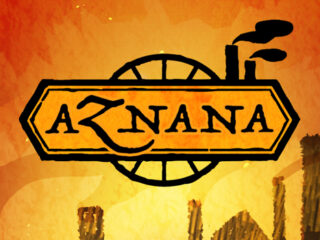 Drift Mania: Street Outlaws is the third installment in a series by Ratrod Studio, a Quebec-based shop of mobile and social game veterans also responsible for Hockey Fight Pro (funny in concept, frustrating and shallow in execution) and Mike V: Skateboard Party (a perfectly competent and perfectly generic Tony Hawk clone). Drift racing is all about pushing your car to the edge of control through deliberate oversteer; it’s a discipline that rewards style and showmanship as much as speed, making it a perfect fit for game adaptation. Drift Mania: SO does a mostly competent and occasionally thrilling job of capturing the feel of the sport, but its narrow focus and a number of significant design issues make it hard to recommend to all but die-hard fans of this specific kind of racing.
Drift Mania: Street Outlaws is the third installment in a series by Ratrod Studio, a Quebec-based shop of mobile and social game veterans also responsible for Hockey Fight Pro (funny in concept, frustrating and shallow in execution) and Mike V: Skateboard Party (a perfectly competent and perfectly generic Tony Hawk clone). Drift racing is all about pushing your car to the edge of control through deliberate oversteer; it’s a discipline that rewards style and showmanship as much as speed, making it a perfect fit for game adaptation. Drift Mania: SO does a mostly competent and occasionally thrilling job of capturing the feel of the sport, but its narrow focus and a number of significant design issues make it hard to recommend to all but die-hard fans of this specific kind of racing.
The first of these issues is the awkward and beginner-unfriendly controls. By default, you manage the throttle with an adjustable slider, activate the handbrake by pressing an icon on the other side of the screen, and steer by tilting your device. Unfortunately, the throttle slider has poor sensitivity at the top of its range, and it’s both hard to see exactly how much throttle you’re applying with your thumb over the slider, and easy to accidentally put on more gas than you intend. As for the handbrake controls, they don’t provide enough feedback: the graphical difference between a raised and lowered handbrake is too slight to easily perceive out of the corner of your eye, and, in a bizarre and glaring oversight, your car’s brake lights don’t light up to help guide you.
Steering, too, doesn’t feel responsive enough on the default setting, requiring your to tilt your phone or tablet more than is comfortable (not to mention making you look like an overexciteable doofus if you’re playing on your commute – which I wouldn’t recommend regardless as you really need the use of both your hands to control the action). To be fair, the steering sensitivity can be adjusted, and you’re likely to find an acceptable setting among the five available. There are likewise welcome options to switch to a gas/break pedal control scheme, use an on-screen steering wheel for steering (this really didn’t work for me, as you need three hands for wheel, handbrake, and throttle), and even move the controls around the screen freely until you find the most comfortable locations. On balance, though – and especially in combination with the unforgiving combo system, which kills your streak at the lightest contact with a barrier or even if you simply go too far off road – the controls don’t feel forgiving enough to be beginner-friendly, and will likely sometimes frustrate even true experts.
Another big issue is how the progression and upgrade systems conspire to pressure you into spending more money. To be sure, the game isn’t strictly pay-to-play: an extremely dedicated player will eventually be able to unlock all 13 tracks (all set in real world locations and competently if blandly modeled and textured), 20+ cars, and 40+ performance upgrades (that’s 40+ per car). But when I say “extremely dedicated player”, I mean extremely. Purchasing all of the above would cost easily over a million in in-game currency, and you earn somewhere in the range of a few hundred to a thousand per race. So, yes, that’s 1000+ races to catch ’em all.
It also doesn’t help Ratrod that Asphalt 8, the latest installment in Gameloft’s flagship mobile racing franchise, has added drifting mechanics to go with its slicker menu design, more generous progression, juicier graphics and more thrilling sense of speed. Unless you’re a hardcore drifting purist who won’t mind putting up with the above shortcomings to get a more focused experience, and won’t miss the absence of a gymkhana mode (check out Driftkhana or Pure Drift if that’s your bag), you’ll get more and harder kicks out of Asphalt 8 at the same price.
*
*



























